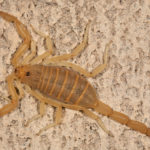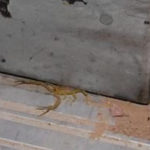General information
Bark scorpions are nocturnal and spend the day hiding under the loose bark of trees and logs, under stones, pine cones, plant leaves, and other objects on the ground. They do not construct burrows for themselves, but have been found occupying burrows made by other animals. They also have a relatively mobile lifestyle that can include climbing, prey stalking, and active foraging. They will climb vertical walls, but do not generally make it far across a horizontal ceiling.
Urban environments and school campuses provide ample hiding places for bark scorpions. Nighttime lighting around buildings attracts large numbers of flying insects and consequently can provide a consistent food supply for scorpions. Some schools may be located in “scorpion hot spots” and have chronic problems with scorpions.
Most scorpion species are solitary, but some bark scorpions may be found in dense groups, spending the winter in groups of 20 to 30 in refuge sites known as hibernacula.
Identification
There are approximately 90 different kinds of scorpions in the United States, most of which occur west of the Mississippi River. Bark scorpions (scorpions in the genus Centruroides, Family Buthidae) include some of the most common and widespread scorpion types. Although all bark scorpions can deliver a painful sting, only one of the Centruroides species, the Arizona bark scorpion, is considered potentially deadly. Most other (non-bark scorpion) genera in the U.S. are not considered medically important.
Centruroides bark scorpions are relatively easy to identify by the way they hold their tails when at rest. They tend to hold their tails curled to the side, rather than upright over the body like most other scorpions. Bark scorpions are usually less than 3 inches long and have relatively slender pinchers (pedipalps). They have a triangular sternum on the underside of the body.
 The common striped bark scorpion, Centruroides vittatus, has two broad, dark bands running longitudinally from the head to the base of the tail. It is the most commonly found bark scorpion species in the southern United States (from Colorado and New Mexico, east to Mississippi and Louisiana with isolated populations in Tennessee and North Carolina). Several other species of Centruroides scorpions (along with other genera of scorpions) may be encountered in the southern and western regions of the United States.
The common striped bark scorpion, Centruroides vittatus, has two broad, dark bands running longitudinally from the head to the base of the tail. It is the most commonly found bark scorpion species in the southern United States (from Colorado and New Mexico, east to Mississippi and Louisiana with isolated populations in Tennessee and North Carolina). Several other species of Centruroides scorpions (along with other genera of scorpions) may be encountered in the southern and western regions of the United States.
 The Arizona bark scorpion, Centruoides suclpturatus, is a concern for schools in Sonoran desert areas of the United States and Mexico. It is found in Arizona, New Mexico, and the Mexican states of Sonora and Chihuahua. It is also found in restricted areas of Nevada, Utah, and possibly California. Compared with other desert southwest scorpions, the Arizona bark scorpion has long, slender pinchers (peidpalps) without lines or carinae. It has a long, slender tail (metasoma). Coloration varies from tan, yellowish or buff. It does not have long hairs (setae). The metasoma is long, slender, and lacking apparent setae (hairless–in contrast to the club of Vaejovids and setae of Hadrurus) and held at the side and often coiled. Metasomal segments are subequal in length, tending to be longer and thinner in males.
The Arizona bark scorpion, Centruoides suclpturatus, is a concern for schools in Sonoran desert areas of the United States and Mexico. It is found in Arizona, New Mexico, and the Mexican states of Sonora and Chihuahua. It is also found in restricted areas of Nevada, Utah, and possibly California. Compared with other desert southwest scorpions, the Arizona bark scorpion has long, slender pinchers (peidpalps) without lines or carinae. It has a long, slender tail (metasoma). Coloration varies from tan, yellowish or buff. It does not have long hairs (setae). The metasoma is long, slender, and lacking apparent setae (hairless–in contrast to the club of Vaejovids and setae of Hadrurus) and held at the side and often coiled. Metasomal segments are subequal in length, tending to be longer and thinner in males.
Habitat Information
Buildings and related structures provide numerous hiding places (harborage) for scorpions. Daytime harborage helps scorpions avoid extreme temperatures and desiccation. Common harborage sites include exterior foundation cracks, hollow block walls, wall voids, wood and equipment stored on the ground. They may also be found under exterior stucco or tile finishing.
Most scorpions gain access into schools through gaps under exterior doors. This can be prevented by well-sealing door sweeps and weather-stripping. One test of doorways is to check whether light can be seen under the doorway from the inside. While indoors, scorpions will hide in various spaces such as behind baseboards, in furniture, within appliances, and in clutter.
Scorpions may also access wall voids by way of weep holes or around electrical face plates, pipes and other penetrations or gaps in the building envelope. Basement window wells may also serve as access points on some campuses.
Despite being well adapted to desert environments, Arizona bark scorpions prefer (riparian) environments close to natural or artificial water, including irrigated landscapes. Areas around turf and planters that are flood or sprinkler-irrigated provide a ready water source for scorpions. Bark scorpions are somtimes seen drinking from droplets of water.
Scorpions need very little to eat and are not easily starved out of an area. As the sole means of control, pesticide applications to control insects around a structure is not likely to eliminate scorpions.
Suggested Thresholds
In areas where the Arizona bark scorpion does not occur, scorpions in school buildings or on school grounds should not be a major cause for medical concern. However, because of the risk of anaphylaxis and general fear of scorpions, thresholds for all scorpions in indoor areas will generally be low.
- Teacher or student reports of scorpion sightings
- Work order reports of scorpions being found at entry points, store rooms, or other occupied areas.
Monitoring and Inspection

Bark scorpion entering a building under a door
In areas where scorpions are common initiate door sweep and building exterior inspections at the first report of a scorpion in a school building. Sealing door thresholds and building penetrations, along with sanitation improvements around building perimeters will often eliminate a problem. With multiple reports of scorpions in a single building, it is helpful to have renewed inspections and efforts to seal the building; informational outreach to students, teachers, and staff on scorpion safety; and outdoor insecticide applications.
Sticky monitoring traps readily catch scorpions and can be used to identify entry points. Inspecting for scorpions during the day is inefficient and often unsuccessful. Scorpions are among the few animals that fluoresce, or glow, under UVB black light. Black-light-assisted inspections of campus grounds after dark can help determine high density areas and the habitat favored by scorpions. Sometimes dozens of scorpions may be observed with black light on walls where they may be collected or sprayed directly.
Nighttime scorpion hunting can be simple and easy, but make sure you wear boots or closed-toe shoes. Long tongs or forceps, such as feeding tongs from reptile stores, are safe tools if you want to capture the scorpions to remove them. You can order powerful black lights from the internet or buy weaker ones from pet stores and electronic retailers.
Once collected, keep the scorpions in a sealable, sturdy container (buckets work well as they cannot climb up the slippery sides). Since these native creatures are beneficial to our environment, consider collecting and releasing the scorpions into the natural desert rather than killing them. Old mesquite wash areas serve well. Alternatively, they can be frozen.
Individual scorpions may be safely captured alive by placing a cup or bowl over them. Scorpions are fast runners, but periodically stop and freeze in place, making such capture relatively easy. Once captured under the cup, slip a stiff piece of cardboard or similar material under it. It should then be easy to turn the cup over and cover and remove the scorpion from the building. Instruct teachers in this method and tell them to never attempt to capture a scorpion by hand.
Non-chemical Control Measures
Sanitation/Cultural
- Keep grass closely mowed and minimize low-growing ground cover vegetation next to buildings.
- Prune bushes and overhanging tree branches away from structures. Tree branches can provide a path to the roof for scorpions.
Physical/Mechanical
- Install tight-fitting door-sweeps and/or thresholds on all external doorways.

- Use weather-stripping, excluder mesh, or good quality elastomeric sealants to seal windows, building cracks, or utility penetrations.
- Seal gaps under flashing along roof lines and ledges that are an 1/8 inch or larger, scorpions will chase their prey even at roof lines.
- Remove trash, construction materials, excessive mulch, loose stones, and other objects to reduce scorpion harborage around school buildings and playgrounds.
- Replace loose mortar in brick or stone walls because it can provide hiding places for scorpions.
- Weep holes (ventilation ports in the exterior stone or brick facade of a building) may provide additional entry points for scorpions. Fit weep holes in brick veneer with air-permeable screening or other pest exclusion materials.
Chemical Control Measures
Pesticides may provide some suppression of scorpions; however, they should not be relied on as a sole control method. Both granular and spray-on insecticides may provide some residual activity against scorpions. Such applications may be more effective when applied late in the day or at night when scorpions are most active, especially in desert areas.
- Wettable powder and microencapsulated formulations of sprayable insecticides generally provide longer-lasting residual activity than emulsions or flowable formulations.
- Fourth-generation pyrethroid insecticides such as deltamethrin, lambda-cyhalothrin, cyfluthrin, bifenthrin, and esfenvalerate seem to provide better control and have better stability under sunlight than other pyrethroids.
- Generally, applications of insecticides for scorpions should be restricted to outdoor areas. Read and follow all directions on the label.
